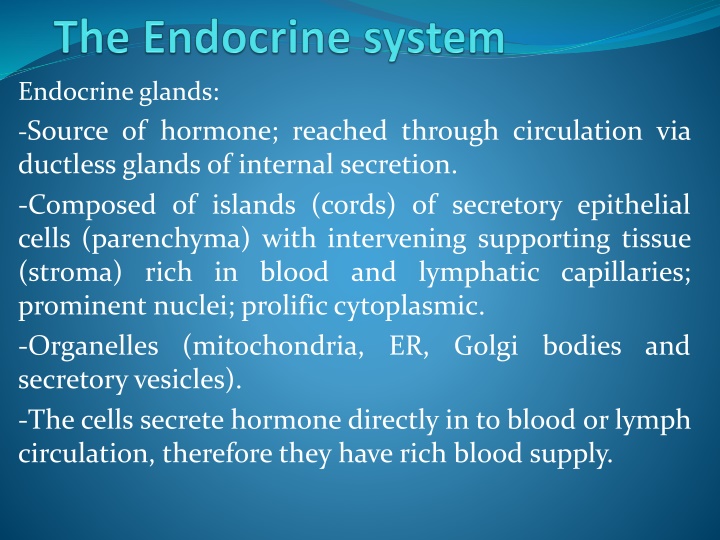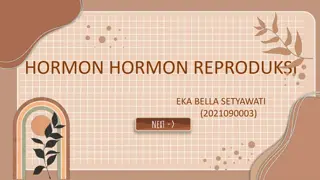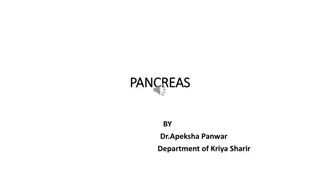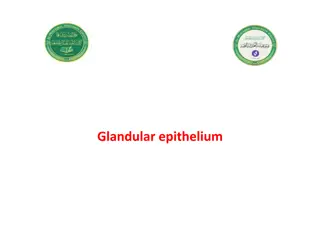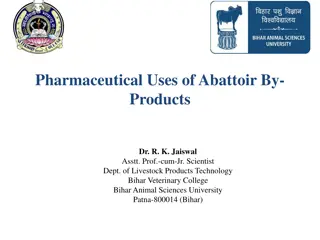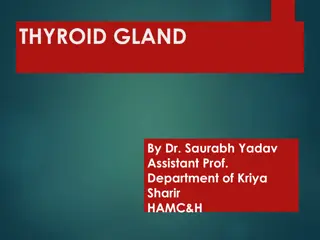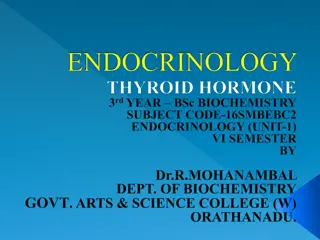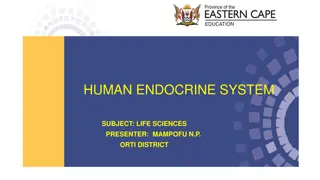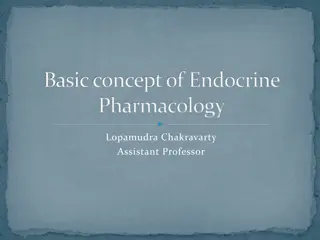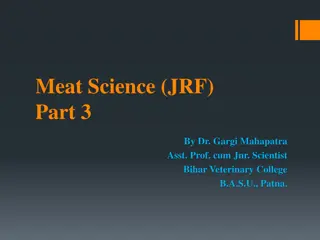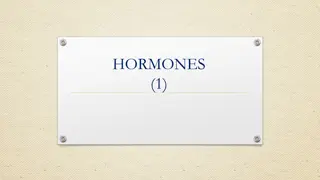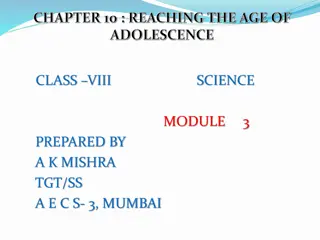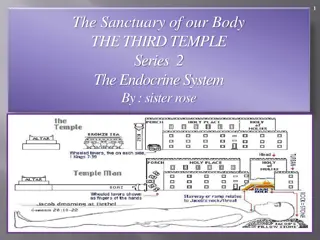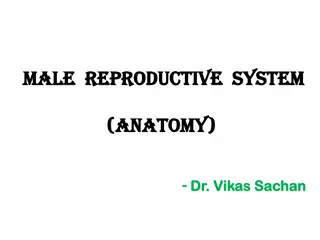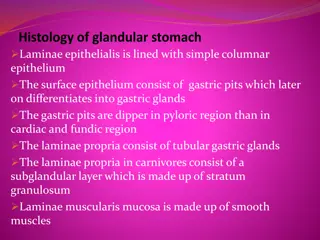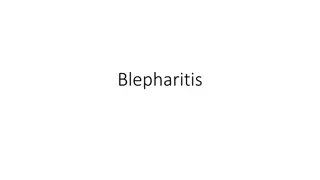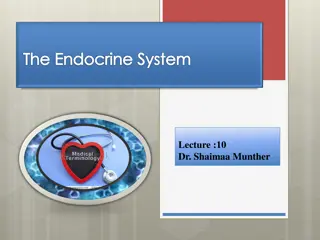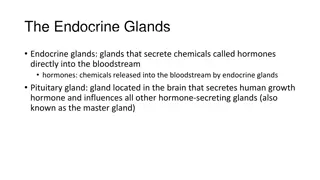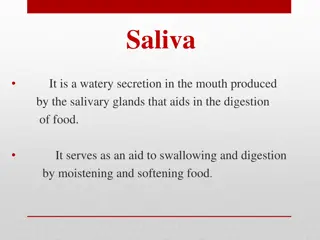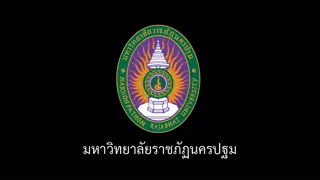Overview of Endocrine Glands and Hormones
Endocrine glands are ductless glands that secrete hormones directly into the bloodstream. They consist of secretory epithelial cells and supporting tissue rich in blood vessels, with prominent nuclei and organelles. Hormones produced by endocrine glands regulate various body functions. This article covers the structure and function of pituitary gland, thyroid gland, and hypothalamus, as well as the hormones they secrete.
Download Presentation

Please find below an Image/Link to download the presentation.
The content on the website is provided AS IS for your information and personal use only. It may not be sold, licensed, or shared on other websites without obtaining consent from the author.If you encounter any issues during the download, it is possible that the publisher has removed the file from their server.
You are allowed to download the files provided on this website for personal or commercial use, subject to the condition that they are used lawfully. All files are the property of their respective owners.
The content on the website is provided AS IS for your information and personal use only. It may not be sold, licensed, or shared on other websites without obtaining consent from the author.
E N D
Presentation Transcript
Endocrine glands: -Source of hormone; reached through circulation via ductless glands of internal secretion. -Composed of islands (cords) of secretory epithelial cells (parenchyma) with intervening supporting tissue (stroma) rich in blood and lymphatic capillaries; prominent nuclei; prolific cytoplasmic. -Organelles (mitochondria, ER, Golgi bodies and secretoryvesicles). -The cells secrete hormone directly in to blood or lymph circulation, therefore they have rich blood supply.
*Endocrine glands are either found as separate unite like: 1-Pituitary gland. 2-Thyroid gland. 3-Parathyroid gland. 4-Adrenal orsuprarenal gland. 5-Pineal body. *Or found as scattered masses within the exocrine gland-called mixergland like: 1-Islet of pan crease. 2-Leydig cells of (interstitial cells of the testes). 3-Corpus luteum of the ovary.
1-Pitutary gland (hypophysis): 1cm in diameter, weight 0.5, in female during pregnancy reach to 1 gm, have two lobes: -Anterior pituitary: develops as outgrowth of hypophyseal (Rathke s) pouch, as upgrowth from the roof of the mouth. Anterior lobe oradenohypophysis of 3 parts: _pars distal is: it is the largest subdivision constitute about 75% of anterior pituitarysurrounded bycollagen fibers. _pars intermedium : -thin zone tissue lying between the pars distalis and pars nervosa. -cells basophilic, function in adult is not clear, but in the fetus the basophils may synthesizes and secretes melanocyte stimulating hormone (MSH), important for melanocyte activity.
_pars tuberalis: is a funnel-shaped region surrounding the Infundibulum of the neurohypophysis (most of the cells of this region are basophilic gonadotropic cells that secret FSH and LH). *Hormones of interiorpituitary: -Growth hormone(GH) -Prolactin(PRL) cells=Mammotrope. -Thyroid stimulating H(TSH) -FSH &LH -Adrenocorticotropin (ACTH) _Posterior lobe(Neurohypophysis): -develop as down growth from the floor of the brain (Diencephalon). -Consist of three parts: 1-Median eminence. 2-Infundibularstalk. 3-Infundibular process (pars nervosa). -Somatotropecells. -lactotrope -Thyrotrope cells. -Gonadotrope. -Corticotrope.
*Hypothalamus: -control secretion of all pituitary hormones. -located in small depression of sphenoid bone (Sella turcica). *Hormones of posterior pituitary: -Antidiuretic hormone(ADH)=synthesized mainly by neurons of hypothalamic supraoptic nucleus. -Oxytocin =synthesized paraventricular of hypothalamus. mainly by neurons of
2-Thyroid gland: is surrounded by 2 capsules: -The outer is thick continuouswith the deepcervical fascia. -The inner, true, CT capsule sends in septa to partially enclose lobules. In the lobules are rounded or bodies-follicles, in a loose stromaof ctwith many blood vessels. _Thyroid follicle: -In man, they vary between 0.02 and 0.9 mm in diameter, a gland has several million follicles. -filled with viscous fluid-thyroid colloid-variablyacidophil. -thyroid follicles are irregular, spherical structures; single layer range from squamous or cuboidal to columnar depending on the activityof the gland.
-epithelial cells+basment membrane ;variable in size, contain homogeneous thyroid or thyroglobulin which consist of glycoprotein, mucoprotein and proteolytic enzyme. -in active gland ;follicles small, colloid diminishes, cuboidal lining high, less active gland, lining cells flattened mostly lined follicular cells, a basal lamina outside which is an extensive plexus of blood capillaries with reticular fibers and fibroblast. -follicular cells are surrounded the follicle lumen, the nucleus is central. -thyroid stimulated by thyroid-stimulating hormone (thyrotropin) adenohypophysis. by basophilic cuboidal
-thyroid follicles epithelial cells absorb iodide and concentrate it from blood by an iodide pump in basal plasma membrane ; iodide oxidized to iodine and transported in to follicular lumen; combines with thyroxin residues of thyroglobulin which remain bound to glycoprotein. -polypeptide hormone calcitonin; lowers blood calcium by inhibiting rate of decalcification of bone by osteoclastic resorption osteoblastic activity ; regulated by blood calcium levels. Para follicular cells (C or clear cells) present in follicle walls but not extending to colloid in interfollicular spaces; synthesize and secret calcitonin. and by stimulating
3-Parathyroid gland: Embedded in capsule of thyroid gland, thin fibrous capsule , delicate septa divide gland in to dense, cord-like of secretory cells, regulate serum calcium and phosphate levelsvia parathyroid hormone. _Two types secretory cells: 1-Chief (principle) cells: secret parathyroid hormone; prominent nucleus and relatively little cytoplasm, actively secreting cells, representabout 20% of total. 2-Oxyphil cells: larger , less numerous, tend to clump among chief cells, smaller densely stained nuclei, strongly eosinophilic cytoplasm containing fine granules, function unknown.
4-Adrenal glands(Suprarenal) : -are paired organs that lie near the superior poles of the kidney, embedded in perirenal adipose tissue. -They are flattened structures with a half moon shape, about 4-6 cm long, 1-2 cm , 4-6 mm thick in adults. -adrenal glands are each covered by a dense c.t capsule that send thin septa to the interior of the gland as trabeculae, the stroma consist mainly of a rich network of reticular fibers that support the secretory cells, the gland consist of two concentric layers ;a yellowish peripheral layer, the adrenal cortex and a reddish brown central layer, the adrenal medulla with prominent central vein.
_Steroid secretory cells: -mitochondriawith unusual tubularcristae. -secretes steroid hormones, structurally related to common precursor cholesterol, regulated by ACTH; 3 functional classes: 1-mineralocorticoids 2-glucocorticoids 3-sex hormones _Adrenal Cortex : -zona glomerulosa: moderately appearance, secretory cells in rounded clumps, round strongly stained nuclei, little cytoplasm, some lipid droplets. Secret mineralocorticoids (aldosterone) : regulation body sodium in renal tubules, blood pressure regulation, aldosteronecontrolled by juxtaglomerularapparatus.
-Zona fasiculata: parallel narrow cords of secretory cells arrange in column 1-2 cell thick, parallel to each other; cells large, abundant cytoplasm, large amount of lipid droplets appears as vacuoles which represent the steroid hormone. Secret glucocorticoids (Cortisol), regulating glucose, fatty acid, metabolism and response to stress; controlled by ACTH also small androgenic sex hormones. -Zona reticularis: small closely-packed cells in irregular network of branching cords and clumps, cells smaller than those of Z. fasciculata, eosinophilic cytoplasm, few lipid droplets, cytoplasm stains more strongly, lipofuscin, probably secret small quantities androgens and glucocorticoids.
_Adrenal medulla secretory cells: -large granular nuclei, extensive, strongly basophilic cytoplasm. -secretes catecholamine hormones: adrenaline and noradrenalin under direct preganglionic sympathetic nervous control; not secreted continuously, stored in cytoplasmic granules and released in response to nervous stimulation after chrome salt fixation, stored catecholamine granules from brown color chromaffin cells. 5-Pineal Body: The seat of the soul-the third eye -pineal evagination from posterior part of roof of third ventricle in midline, connected to brain via short stalk containing nerve fibers (from hypothalamus).
-pineal concentric phosphate within an organic matrix. -pinealocytes; pineal chief cells, highly modified neurons arranged in clumps and cords surrounded by rich net work of fenestrated capillaries, round, granular nuclei with prominent nucleoli and poorly stained cytoplasm; highly branched processes. -contain variety of indole compounds including melatonin and its precursor serotonin. sand (basophilic layers extracellular calcium bodies) of and magnesium
